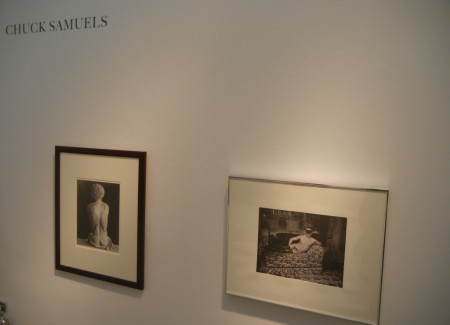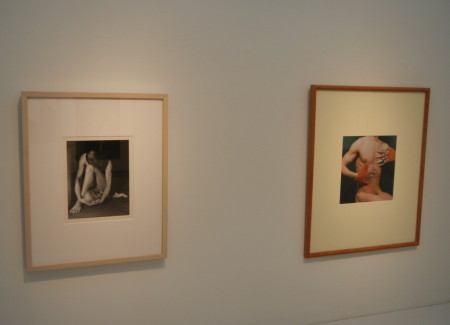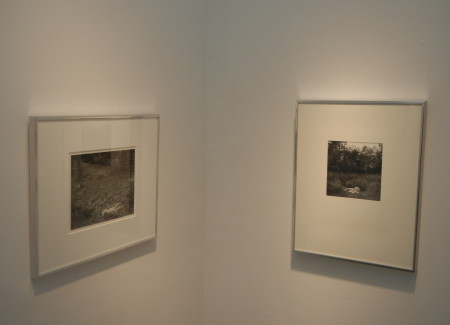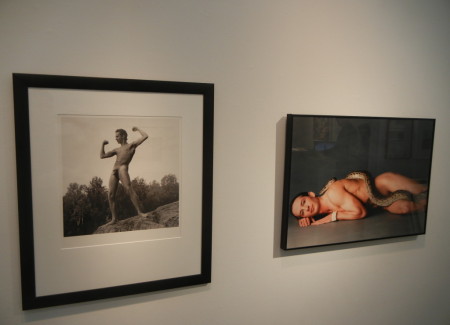JTF (just the facts): A total of 12 black and white and color photographs, variously framed and matted, and hung against white walls in the small back gallery space. The works on view are a mixture of gelatin silver prints (some with selenium or other toning), Polaroid SX70 prints, Kodak R-4 prints, and archival inkjet prints, made in 1990 or 1991. Physical sizes range from 3×3 to 22×30, and the prints are each available in an edition of 20, regardless of the size or process. This is the photographer’s first solo show in New York. (Installation shots below.)
Comments/Context: Even after feminist theorists identified (and named) the dominance of the “male gaze” over the long arc of art history, getting out from under its pervasive and often quietly invisible influence hasn’t always been easy. While we have all come to identify the aesthetic hallmarks of a heterosexual male artist looking at a female subject, and also to be aware of the visual and emotional differences implicit in a female gaze, we don’t often get a crisply logical proof of the concept like the one found in this small show. Especially for a critic like myself (who by definition sees the world through a set of heterosexual male eyes, however much I might try to be more neutral and open), this tightly edited exhibit of the early 1990s work of Chuck Samuels provides a thoroughly engrossing refutation of the male gaze, using a parade of thought provoking inversions to dismantle an often implicit perspective.
Samuels has started with some of the most iconic, elegant, and powerful female nudes drawn from the long history of photography, and then meticulously restaged each one, substituting himself for the female subject. From the compositions to the photographic processes, the works are painstaking duplicates, pictures that mirror the originals with astonishing fidelity. Like Yasumasa Morimura’s gender reversed recreations of Frida Kahlo and Marilyn Monroe or his restagings of artists as varied as Johannes Vermeer and Cindy Sherman, the introduction of a man into the portrait of a woman can certainly lead to some surprising dissonance.
But Samuels’ choice of nudes (both those driven by formal concerns and those of a more seductive variety) and the substitution of a male body (not just a head) for the original female one pushes his works even further than Morimura’s. While his restagings of Harry Callahan’s Eleanor in the wooded meadow, Wynn Bullock’s nude in the carpet of leafy undergrowth, and Man Ray’s Le Violon d’Ingres aren’t immediately obvious as populated by male intruders (all of the nudes are shot from the back), it’s the subtle inclusion of a penis in many of the most revered and classic female nudes that really creates an altered perception.
Take Edward Weston’s famous folded legs nude of Charis. Samuels’ version is equally linear, and surprisingly luminescent, and yet now it’s undeniably a male nude. The same goes for the restaging of Emmet Gowin’s portrait of Edith peeing in the doorway – the riskiness of the picture feels starkly different when a man stands pantless silhouetted by the light. And the subtle erotic equation of Ralph Gibson’s feather-caressing back side is certainly changed by the hanging male genitals.
Not only do Samuels’ images probe the subtleties of the male gaze, they double down and push on the homo/hetero sexual balance as well. EJ Bellocq’s masked prostitute is now male, as is Paul Outerbridge’s torso bring poked by knife point fingers. In each case, the original eroticism has been transformed by the gender switch, the “gaze” now charged with a different electricity. His reworking of Avedon’s Nastassja Kinski and the Serpent is similarly undermined, the symbolism of the seductive snake licking her ear creating an altogether more offbeat mood when the sinuous subject is Adam not Eve.
Restaging the masterworks of photography is a task fraught with artistic danger – a clever homage often quickly turns into a jokey (and forgettable) one liner (just ask John Malkovich). Chuck Samuels’ work has smartly tapped into something deeper than the simple switcheroo. Standing with his arms flexed, mimicking the confident position of Mapplethorpe’s body builder Lisa Lyon (her original physique more ripped than his own by the way), we don’t just get a celebratory laugh of recognition. We instead get presented with a series of complicated questions about gender roles and stereotypes of physical beauty/power that are left tantalizingly open ended. While Samuels’ work is undeniably aimed at the knowledgeable photo insider who will appreciate his insightful conceptual thinking, many of these photographs will still be gratifyingly perplexing for those who can’t quite place the allusions.
Collector’s POV: The prints in this show are priced at either $1200 and $2000, generally based on size. Samuels’ work has little secondary market history, so gallery retail remains the best option for those collectors interested in following up.










